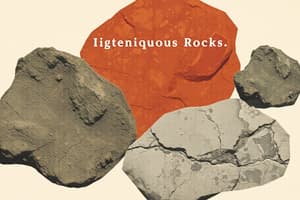Podcast
Questions and Answers
What defines a rock?
What defines a rock?
- A naturally occurring solid aggregate of one or more minerals (correct)
- A liquid substance found beneath Earth's surface
- A solid mineral with no other components
- A crystalline structure formed from lava
Which type of igneous rock cools slowly beneath the Earth's surface?
Which type of igneous rock cools slowly beneath the Earth's surface?
- Metamorphic rock
- Extrusive/Volcanic rock
- Plutonic rock (correct)
- Sedimentary rock
Which of the following textures is characterized by fine grains?
Which of the following textures is characterized by fine grains?
- Phaneritic
- Aphanitic (correct)
- Glassy
- Porphyritic
What type of metamorphism occurs primarily due to heat from contact with magma?
What type of metamorphism occurs primarily due to heat from contact with magma?
Which rock is classified as metamorphic?
Which rock is classified as metamorphic?
What is an example of a felsic igneous rock?
What is an example of a felsic igneous rock?
Which concept describes the transformation of one rock type into another?
Which concept describes the transformation of one rock type into another?
Regional metamorphism is commonly associated with which geological feature?
Regional metamorphism is commonly associated with which geological feature?
What is the primary cause of contact metamorphism?
What is the primary cause of contact metamorphism?
Which characteristic does NOT describe minerals?
Which characteristic does NOT describe minerals?
What type of sedimentary rock is formed from the accumulation of little pieces of broken rocks and shells?
What type of sedimentary rock is formed from the accumulation of little pieces of broken rocks and shells?
How do foliated metamorphic rocks differ from non-foliated metamorphic rocks?
How do foliated metamorphic rocks differ from non-foliated metamorphic rocks?
What process leads to the formation of sedimentary rocks from accumulated layers of sediments?
What process leads to the formation of sedimentary rocks from accumulated layers of sediments?
Which of the following is an example of a chemical sedimentary rock?
Which of the following is an example of a chemical sedimentary rock?
Which property of minerals relates to their resistance to scratching?
Which property of minerals relates to their resistance to scratching?
What results in a mineral's streak?
What results in a mineral's streak?
Flashcards are hidden until you start studying
Study Notes
Rocks
- Earth’s solid rock extends to a depth of 2,900 kilometers where it transitions into the liquid outer core.
- Rocks are natural solid aggregates of one or more minerals, bonded together chemically.
- Geologists classify rocks into three categories: igneous, sedimentary, and metamorphic.
- Petrology is the scientific study of rocks.
Igneous Rocks
- Formed from the hardening and crystallization of magma deep within the Earth.
- Two types of igneous rocks:
- Extrusive/Volcanic: Formed from lava at Earth’s surface; characterized by fine-grained crystals.
- Intrusive/Plutonic: Formed from magma cooling slowly underground; features large, coarse-grained crystals.
- Igneous rocks are classified based on:
- Composition:
- Felsic: Light-colored, contains feldspar and silicates.
- Mafic: Dark-colored, rich in magnesium and iron.
- Intermediate: Between mafic and felsic.
- Ultramafic: Very dark in color.
- Texture:
- Aphanitic: Fine-grained.
- Phaneritic: Coarse-grained.
- Porphyritic: Contains both large and small crystals.
- Glassy: Non-ordered solid, formed from rapid cooling.
- Pyroclastic: Composed of ejected volcanic fragments.
- Composition:
Metamorphic Rocks
- Formed from pre-existing rocks (igneous, sedimentary, or metamorphic) through metamorphism.
- Typically found deep within the Earth or at tectonic plate boundaries.
- Two types of metamorphism:
- Regional Metamorphism: Caused by pressure and temperature changes over large crustal regions, often associated with convergent plate boundaries.
- Contact Metamorphism: Occurs due to heat from nearby magma, not pressure-related, resulting in non-foliated rocks.
Classification of Metamorphic Rocks
- Texture: Size and arrangement of mineral grains.
- Foliation: Planar arrangement of mineral grains.
- Foliated: Banding or layering present (e.g., mica).
- Non-foliated: Few minerals, no banding.
Sedimentary Rocks
- Provide insights into Earth’s past surface conditions.
- Formed from the accumulation of sediments (sand, shells, pebbles) that harden over time due to compaction.
- Three types of sedimentary rocks:
- Clastic: Formed from accumulated clasts; examples include conglomerate and sandstone.
- Chemical: Formed from precipitated minerals from solutions; example: halite.
- Organic: Formed from the accumulation of biological debris; example: coal.
Minerals
- Building blocks of rocks defined by specific criteria:
- Naturally Occurring: Formed through natural processes of Earth.
- Inorganic: Not produced by biological processes.
- Homogeneous Solid: Has a definite volume and rigid shape.
- Definite Chemical Composition: Can be represented by a chemical formula.
- Orderly Crystalline Structure: Atoms arranged in a repetitive, orderly pattern.
Properties of Minerals
- Color: Can vary based on surface conditions.
- Streak: Color of the powdered form of a mineral.
- Hardness: Resistance to scratching.
- Cleavage: Ability to break along specific planes.
- Crystalline Structure: Describes the internal arrangement of atoms.
Studying That Suits You
Use AI to generate personalized quizzes and flashcards to suit your learning preferences.




